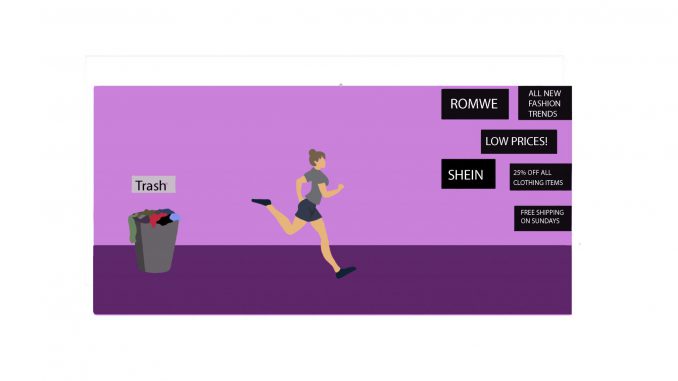
By Jayden Kimpel, Staff Writer & Copy Editor

As a plus-sized woman, I can’t even recount the amount of times that I have been jealous of another person’s outfit. I would ask where they got it, and their one word answer would soon send me down a spiral of self-loathing and extreme body dysmorphia.
What was their answer? Shein.
Shein is a widely popular company known for its fast fashion and savvy use of social media. Many influencers and internet celebrities praise Shein for its affordability and fast shipping rates. I remember logging onto my computer and immediately going to their website. They had a whole section dedicated to women that are my size. After scrolling for what it felt like hours through their plus-size section, I finally found a few things that matched my interest – a pair of jeans and a long-sleeved blouse. I waited all weekend with my nose pressed to my window just waiting for my package to arrive. When it finally came, I ripped it open and immediately tried to put on my new clothes. (Spoiler: They didn’t fit.)
As soon as I put the jeans on, they were an immediate crime to humanity. The blouse had the consistency and feeling of a bathing suit, along with the pants. Every curve, indent, and bump on my skin was made very obvious. It was a blouse and jeans – how could a blouse and jeans that were one size bigger than my usual shirt and pants size be that sheer and tight? I made sure I had bought the correct size, so what really happened? Why didn’t my clothes fit at all?
Humans are now consuming 400% more clothing compared to 20 years ago, along with the average American generating more than 82 pounds of textile waste every single year. We are buying more clothes than ever before, and wearing them a lot less because of the fear of “recycling outfits”. Why is this even happening? Short answer: mass-produced fast fashion.
Some may ask, what is fast fashion? It’s not similar to fast food, where your items are made on the spot right there. Fast fashion are brands that massively produce high volumes of low quality clothing throughout the year. They now make clothes at a fraction of the price of other clothing brands.
These fast fashion companies are often extremely vague and not entirely transparent about their suppliers and how their products are made. They usually don’t give any specific information about what exactly they’re doing to alleviate their environmental impact. They also do not provide evidence that they offer their workers decent and safe working conditions, as well as living wages. Not only does fast fashion cause textile waste, pollution, and extreme depletion of natural resources- they violate basic human rights and mislead customers.
These cheap prices are a very obvious indication of fast fashion clothing, and their poor quality. It’s practically impossible to produce a $5 T-shirt, along with paying garment workers fairly, along with having eco-friendly manufacturing processes.
Fashion isn’t the only industry that suffers promotion of excess; technology companies constantly push new generations of products that result in mountains of new hazardous waste.
Apple produces new phones every single year with very minimal changes, but it makes people flock to the doors of local technology stores. Looking at the new designs and prices, it only leads me to ask, “Why?” As the owner of a 2017 iPhone 8, I’ve seen new phone designs come and go, only to realize that they look almost exactly the same as the one before.
A large percentage of the people in my area immediately line up outside technology stores to buy the newest model of the iPhone every single year. While I’m happy that they had the disposable money to buy the new phone, I’ve always wondered what was wrong with the phone that they had.
Over 1.5 billion smartphones are sold every year, which means that the same number of smartphones are discarded to god knows where. Discarded could even mean that they could be going to a landfill, recycled, or even stuck in the back of a junk drawer. Many of these 1.5 billion phones don’t even get recycled at all. Only about 15% of this e-waste is recycled. India, China, and Ghana don’t have recycling regulations, so many toxic chemicals and heavy metals are released into the air and waterways, which causes significant harm to people.
The cost to manufacture a new iPhone is about $500, depending on storage size. Phone companies also make the phones obsolete, and almost difficult or impossible to repair or upgrade, causing many to buy a new phone sooner. Along with plastic in the phone, phone cases are mostly made of non biodegradable plastic along with plastic packaging, which overall creates an extra demand for more plastic. Phones also contain valuable and finite materials, which include rare Earth elements, and conflict materials.
Even if you recycle your phones, they do end up in fire and get burnt, which is basically the opposite of being eco-friendly. Burning these phones and electronics creates toxic waste, which pollutes the local and global environment when they produce gas into our atmosphere. We breathe the toxic fumes of our old phones.
Is it really necessary to buy a brand new phone after owning your current one for barely a year?
Be aware of what you buy. The $5 T-shirt that you actually got for $3 using a TikToker’s affiliate link could be the reason as to why workers in other countries are being exploited. The planet is dying due to our excess waste. Let’s try to change that.
————————————–
Guide to Greener Electronics
Source https://www.greenpeace.org/usa/research/guide-to-greener-electronics-2017/
Top Ten Popular Fast Fashion Companies
1. Shein
2. Zara
3. H&M
4. Fashion Nova
5. Forever 21
6. ASOS
7. MANGO
8. Urban Outfitters
9. Primark
10. Boohoo
Source https://www.championhoodie.com/blog/fast-fashion-brands/
